- What is a portable power station?
- What’s included in a portable power station?
- How do you use a portable power station?
- What should I look for when buying a portable power station?
- 5 of the Best Portable Power Stations
- How does a fossil fuel generator differ from a portable power station?
- How many years on average do portable power stations last?
- How much power output do you need from your portable power device for camping?
- How long can you run a portable power station?
- What are the safety tips that you should remember when using a portable power station?
- Where should you store a portable power station?
- Can you leave a portable power station outside?
- How do you properly recycle an old portable power station?
- Can a portable power station run a tv?
- Can a portable power station run a refrigerator?
- Portable Power
- Outdoor Gear
What is a portable power station?
A portable power station, also known as a portable battery pack or portable charger, is a portable device that uses a variety of power sources, including solar panels and lithium-ion batteries, to generate electricity. These power stations are designed to be lightweight and easy to transport, and are often used as a backup power source for homes, businesses, and recreational activities.
Portable power stations are devices designed to provide users with an uninterrupted supply of electricity outside of the home or office. They typically contain a lithium ion battery source and come equipped with a variety of sockets to plug your devices into, including AC, USB A and USB C.
What’s included in a portable power station?
A portable power station typically consists of a housing, a power source (such as a lithium-ion battery or solar panels), and a series of outlets for connecting and charging electronic devices. The power source is charged using an external power source, such as a wall outlet or solar panel, and can then be used to power and charge a variety of electronic devices, such as smartphones, tablets, laptops, and small appliances.
There are several different types of portable power stations, each with its own unique features and capabilities. Some power stations are equipped with USB ports for charging devices, while others may have AC outlets for powering appliances. Some power stations also come equipped with built-in solar panels, which allow them to be charged using sunlight.
How do you use a portable power station?
To use a portable power station, you simply need to charge the power station using an external power source, and then connect your electronic devices to the outlets on the power station. The power station will then provide power to your devices, allowing you to use them even when you don’t have access to a traditional power outlet.
Overall, portable power stations are a convenient and reliable way to generate electricity and keep your electronic devices charged when you’re on the go. They can charge a variety of things, from mobile phones to electric vehicles.
What should I look for when buying a portable power station?
Capacity: The capacity of a portable power station refers to the amount of energy it can store. A power station with a larger capacity will be able to power more devices or appliances, and will have a longer run time.
Output: The output of a portable power station refers to the amount of power it can deliver to your devices at any given time. A power station with a higher output will be able to power more demanding devices, such as laptops and small appliances.
Charging time: The charging time of a portable power station refers to the amount of time it takes to fully charge the power station using an external power source. A power station with a shorter charging time will be more convenient to use.
Number and type of outlets: The number and type of outlets on a portable power station will determine the types of devices you can power. Some power stations have only USB outlets, while others may have a combination of USB and AC outlets.
Size and weight: If you plan on using your portable power station on the go, you’ll want to consider its size and weight. A smaller, lighter power station will be more convenient to carry around.
Durability: Consider the durability of the power station. You’ll want a power station that can withstand rough handling and is built to last.
5 of the Best Portable Power Stations
Jackery Explorer 1000
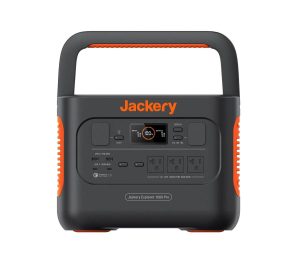
What is the Jackery Explorer 1000 best for? The Explorer 1000 should be used with devices that require 1,000 watts or less of power. It’s a great power station for car camping, although it’s a bit heavy for backpacking or hiking.
- Retail Price: $1,099
- Battery capacity: 1,002 watt hours
- AC output: 1,000 watts
- Solar panel compatible: Yes, with the Jackery SolarSaga 80/W200W Solar Panel
- Time to recharge: 3.6 hours with two 200 watt solar panels or 1.8 hours connected to AC power via a wall outlet.
- Lifespan: 1000 full charge cycles
- Weight: 25.4 lbs (11.5 Kg)
What are the Jackery Explorer 1000 Best Features?
- Fast solar recharge to 100% in less than 2 hours. This is one of the fastest solar recharge times on the market.
- Fast AC recharge to 100% in about 90 minutes.
- Three (3) super powerful 1000 watt AC outlets – significantly more powerful than other power stations.
- Operates in freezing temperatures down to 14 degrees F / -10 degrees C
- Uses a pure sine wave inverter generator to provide a consistent, safe electrical current while also safeguarding against overload and device damage.
- Smart screen display that tells you the battery mode and percent charge.
- Compact and relatively lightweight at 25 pounds, compared to models like the Yeti Goal Zero 1500X which weighs a whopping 45 pounds.
- Pass-through charging allows you to simultaneously power your gadgets and recharge the power station.
What are the Jackery Explorer 1000 negatives?
- It is not waterproof.
- 18 watt USB-C output is weak compared to other brands which provide 60 watt USB-C outlets.
- Jackery portable power stations cannot be expanded by adding more battery packs.
What type of devices can the Jackery Explorer 1000 power?
- Small, medium and large devices up to 1,000 watts. The Jackery 1000 is perfect for camping and household use, including electric space heaters, CPAP machines, televisions, coffee makers, LED lanterns, mobile phones, laptops, portable refrigerators, microwaves, toasters and hair dryers.
What ports come with the Jackery Explorer 1000?
- 8 total ports. 3 1,000W AC ports, 2 USB-A quick charge ports, 2 USB-C ports and 1 DC car port
EcoFlow DELTA Max (2000)
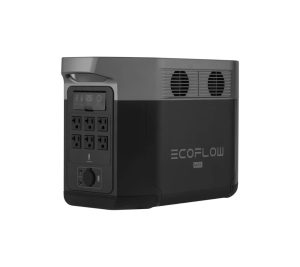
What is the EcoFlow Delta Max best for? The Delta Max should be used with devices that require 2,000 watts or less. It’s a great power source for energy hungry devices or appliances, making it a great home backup system.
- Retail Price: $1,500
- Battery capacity: 2,000 watts, expands up to 6,000 watts
- AC power output: 2,016 watt hours
- Solar panel compatible: Yes, connect up 1-2 220 watt solar panels
- Time to recharge: Full charge in 1.8 hrs via an AC wall outlet, or 3–6 hours using solar panels.
- Lifespan: 800 charge cycles
- Weight: 53 lbs.
What are the EcoFlow Solar Generator DELTA Max best features?
- Battery capacity can be expanded up to 6,000 watts by connecting two additional batteries. This makes the EcoFlow 2000 the ultimate portable power supply for both camping and as a home backup power source.
- Provides a whopping six (6) AC outlets! This is more than most other power stations, making it easy to plug in multiple devices.
- Supports a wide range of devices, from small gadgets to heavy-duty household appliances up to 3400 watts
- The battery recharges from 0% to 80% in less than 75 minutes using an AC wall outlet.
- Charge up to 15 devices simultaneously.
- Remote control app lets you control the solar generator remotely.
What’s the EcoFlow Solar Generator DELTA Max negatives?
- Heavy and difficult to transport for backpacking trips.
What are some of the devices the EcoFlow Solar Generator DELTA Max power?
- 50 watt television, 120 watt refrigerator, 500 watt washing machine, portable space heater.
What ports come with the EcoFlow Solar Generator DELTA Max:
- 14 total ports. Six (6) AC outlets / Two (2) USB A ports / Two (2) USB-A Fast Charge PORTS / Two (2) USB-C ports / One (1) 12 volt car ports.
EcoFlow DELTA mini
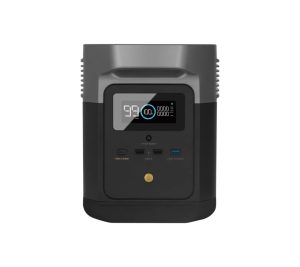
What is the EcoFlow Delta Pro mini best for? The Delta Pro should be used with devices that require less than 800 watts. It’s great for activities that require a continuous power source. The portable power station only requires about 1.5 hours to recharge to 100% via AC.
- Retail Price: $749
- Battery capacity: 880 watt hours
- AC power output: 1,400 watts, expandable to 1,800 watts with X-Boost mode
- Solar panel compatible: Yes, via 300 watt panels
- Time to recharge: Fully recharges via an AC port in about 90 minutes, solar panels in 4-7 hours, 2.5 hours via 300W solar panels.
- Lifespan: 800 charge cycles
- Weight: 23.6 lb
What are the EcoFlow Delta Pro mini best features?
- Provides Five (5) AC outlets with a layout similar to a wall outlet.
- Small and compact, yet packs an incredible amount of power.
- In spite of its relatively tiny size, the EcoFlow Delta mini can support most household appliances.
- Silent operation at 0 decibels.
- Fast recharge.
- Rugged design.
- Robust battery management system that includes surge protection, low temperature protection, and overload protection.
What’s the EcoFlow Delta mini’s worst features?
- Only includes One (1) USB port for fast charging.
What type of devices can the EcoFlow Delta mini power?
- Small, medium and large devices up to 1,400 watts. This includes devices like a 10 watt LED light, 40 watt CPAP, 120 watt refrigerator, 110 watt wide screen television, 500 watt washing machine, 1000 watt coffee maker.
What ports come with the EcoFlow Delta mini?
- 12 total ports. Five (5) AC outlets / Two (2) standard USB-A ports / One (1) USB-A fast charging port / Two (2) USB-C ports / One (1) car 12 volt outlet / Two (2) DC5521 outputs.
Anker 535 Powerhouse
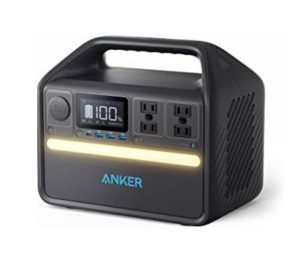
What is the Anker 535 Powerhouse best for? The Anker 535 should be used with devices that require 450 watts or less.
- Retail Price: $699
- Battery capacity: 500 watts
- AC power output: 512 watt /hours
- Solar panel compatible: Yes
- Time to recharge: 2.5 hours plugged into an AC outlet and 4 hours via solar panels.
- Lifespan: 3,000 charge cycles
- Weight: 18.3 Pounds
What are the Anker 535 best features?
- Small and lightweight at only 18 pounds.
- Long lifespan.
- Cool ambient light mode that turns the power station into a chill lightbox, perfect for sitting outside.
- Includes an Anderson port to securely connect to a caravan or camper.
- Silent operation at 8 decibels.
What’s the Anker 535 worst features?
- Does not have a built in surge protector. This puts your devices at risk in the event of a power surge.
- Device screen display can be inaccurate when the product is turned on the first time.
- Does not shut itself off in AC mode, which can drain the battery over a few hours.
What kind of devices can the Anker 535 power?
- Small devices up to 500 watts. The Anker 535 is perfect for small devices like a 50 watt mini fridge, 40 watt fan, 40 watt CPAP machine, 250 watt grill and LED lights. It can only power devices rated 500 watts and less, so larger devices will not work. The Anker 535 can charge a laptop about 10 times, and a mobile phone about 55 times.
What ports come with the Anker 535?
- 11 total ports. Four (4) USB-A ports, Two (2) USB-C ports, Two (2) AC outlets, Two (2) DC outlets, One (1) Anderson outlet.
GOAL ZERO Yeti 500X
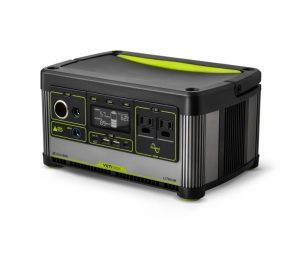
What is the Goal Zero Yeti 500X best for? The Yeti 500X should be used with devices that require 450W and less. At 12.9 pounds, the portable power station is also good for camping trips to include backpacking and hiking. The power station also provides 3 fast-charge outlets and comes with 3 fast charge options, including a USB-C, USB-C PD and a 120W 12V outlet. amping, tailgating,
- Retail Price: $549
- Battery capacity: 505 watts
- AC power output: 300 watt/ hours
- Solar panel compatible: Yes with 100 watt foldable Nomads or mountable Boulder solar panels.
- Time to recharge: Wall charging with 120 W AC outlet takes about 4 hours, solar charging takes about 8 hour
- Lifespan: 500 charge cycles
- Weight: 12.9 pounds
What are the Goal Zero Yeti 500X best features?
- Compact size with a weight of only 12.9 lbs.
- Built-in auto-shut off and surge protection so your devices won’t short circuit.
- Aluminum exterior protects it from damage.
- Runs silently at 0 decibels.
What’s the Goal Zero Yeti 500X worst features?
- Only provides 300 watts of continuous output. This greatly reduces the types of devices that the Yeti 500W can power.
- Overly sensitive power button is too easy to shut on and off.
- Weak USB ports – USB A port is 12 watts and the USB C port is only 18 watts.
- Only One (1) fast charging USB C port.
What type of devices can the Goal Zero Yeti 500X power?
- Small devices up to 500 watts. Cell phone, CPAP machine, LED lantern, laptop.
What ports come with the Goal Zero Yeti 500X:
- 8 total ports. Two (2) AC sockets, One (1) USB-C port, Two (2) USB-A ports, One (1) 12-volt car port, and One (1) 6mm port.
How does a fossil fuel generator differ from a portable power station?
A fossil fuel generator is a type of electrical generator that uses a fossil fuel, such as gasoline, diesel, or natural gas, to generate electricity. These generators are typically large, heavy, and require a constant fuel source in order to operate. They also produce harmful emissions, such as carbon dioxide and other air pollutants.
On the other hand, a portable power station is a smaller, portable device that uses a variety of power sources, including solar panels and lithium-ion batteries, to generate electricity. These power stations are often used as a backup power source for homes, businesses, and recreational activities, and are designed to be lightweight and easy to transport. They do not require a constant fuel source and do not produce harmful emissions.
One of the main differences between a fossil fuel generator and a portable power station is the way in which they generate electricity. Fossil fuel generators use a combustion process to generate electricity, while portable power stations use a variety of power sources, including solar panels and lithium-ion batteries, to generate electricity.
Another difference is the size and weight of the two types of devices. Fossil fuel generators are typically large and heavy, while portable power stations are much smaller and lighter. This makes portable power stations more convenient to transport and use in a variety of settings.
While fossil fuel generators are a reliable source of electricity, they have a number of disadvantages, including the need for a constant fuel source, the production of harmful emissions, and their large size and weight. Portable power stations, on the other hand, offer a clean, convenient, and portable alternative for generating electricity. They are an invaluable tool for eco camping and off grid living.
How many years on average do portable power stations last?
A lithium-ion battery typically has between 500 to 1000 complete charge cycles. A single charge cycle can provide about 8 hours of use with 1 hour of recharge time.
If you used your power station for 33 hours per month, this would deplete 50 charge cycles in one year. At this rate, your power station would last between 10 – 20 years.
If a power station is used for 66 hours per month, this would deplete 100 charge cycles in one year. Your power station would last between 5 – 10 years.
Lithium iron phosphate batteries, also known as LiFePO4 or LFP batteries, are thought to be superior because they have a ten-year life expectancy (twice that of lithium-ion batteries) and faster charging times.
How much power output do you need from your portable power device for camping?
The amount of power you need is determined by the types of electronic device you plan on charging and how long you need to charge them. You should also consider if you will recharge the portable station using AC, solar or DC output. Keeping the power station fully charged will allow you to use it continuously.
- A 200 watt power station can charge devices like a 10 watt LED light, 14 watt bluetooth speaker and 25 watt cell phone charger for 10+ hours.
- A 500 watt power station can run devices like a 40 watt electric blanket, 50 watt mini fridge and 60 watt television for 8+ hours.
- A 1000 watt power station can power a 350 watt space heater and 550 watt coffee maker for 1-2 hours.
How long can you run a portable power station?
The amount of time you can run a portable power station over a single charge cycle depends on the battery capacity and the type of devices you are running.
For example, if your battery capacity is 500 watts you can run a 10 watt LED light for 50 hours. If your battery capacity is 1,500 watts, you can run a 350 watt space heater for about 4 – 5 hours.
If you power station allows you to simultaneously recharge it while powering your devices, you can run it continuously as long as you have access to an AC outlet, solar panels or car charger.
What are the safety tips that you should remember when using a portable power station?
Since portable power stations run on batteries and solar power instead of fossil fuels, they are very safe to use. However, there are some safety tips to consider:
- Keep the power station away from water and moisture.
- Don’t expose the lithium battery to freezing temperatures.
- Always follow the manufacturer’s instructions for use and handling.
- Avoid overloading the power station or using it to power appliances that exceed its rated wattage.
- Keep the power station and its cords in good condition. Replace any damaged cords or appliances immediately.
- Do not open the power station or attempt to repair it yourself.
- Keep the power station away from heat sources, such as open flames or direct sunlight.
- Use only the supplied charging cord or a cord recommended by the manufacturer to charge the power station.
- Do not use the power station if it has been damaged or dropped.
- Keep the power station out of the reach of children.
- Disconnect the power station from the wall outlet before unplugging any appliances.
Where should you store a portable power station?
A portable power station should be stored unplugged in a dry place at temperatures between 50 to 80 degrees. It should be charged to 40% – 60% of capacity, which prevents significant power loss while the battery is not in use.
Can you leave a portable power station outside?
You can use your portable power station outside, but you should not leave it outdoors unattended. You should also not leave it outside where it can get damaged by heat and rain.
How do you properly recycle an old portable power station?
Recycling old portable power stations is an important way to conserve resources and reduce waste. Here are some steps you can follow to properly recycle an old portable power station:
- Check with the manufacturer to see if they offer a recycling program for their products. Many manufacturers have programs in place to properly dispose of old portable power stations.
- Look for a local electronic waste recycling facility. Many cities and towns have facilities specifically designed for the recycling of electronic devices, including portable power stations.
- Contact your local waste management company to see if they offer electronic waste recycling services. Many waste management companies have programs in place to properly dispose of electronic waste.
- Consider donating your old portable power station to a charitable organization or educational institution. These organizations may be able to use the power station or may know of a place where it can be properly recycled.
When recycling an old portable power station, it is important to properly handle and dispose of any hazardous materials, such as batteries and chemicals, that may be present. Follow any instructions provided by the manufacturer or recycling facility for the proper disposal of these materials.
Can a portable power station run a tv?
Yes, a 500 watt power station can run a 60 watt tv for 8 hours. A 1,500 watt power station can run a 60 watt tv for 25 hours.
Can a portable power station run a refrigerator?
A 520 watt full sized home refrigerator can run on a 1500 watt power station for 2 – 3 hours and a 2000 watt power station for 3 – 4 hours.
Fair Trade Finder makes product and service recommendations, based on thorough research and comparison analysis. Read more.
Portable Power
- Jackery vs BLUETTI: Which Portable Power Station is Right for You?
- EcoFlow vs Jackery: Which Portable Power Station Is Best for You?
- Jackery Vs Goal Zero: Which Eco-Friendly Power Source Is Right For You?
- How to choose a portable power station for home use: a comprehensive guide
- Portable Power Station Maintenance Guide: Tips & Tricks
- The Benefits of Portable Power Stations for Natural Disasters






